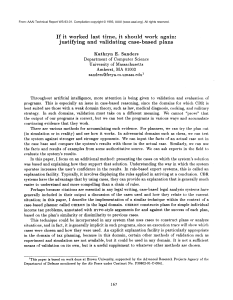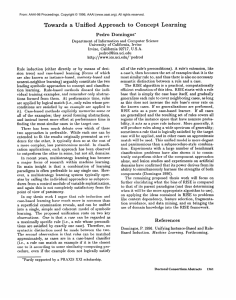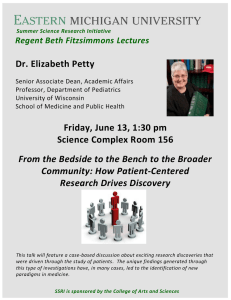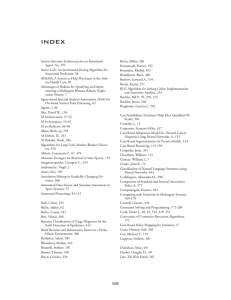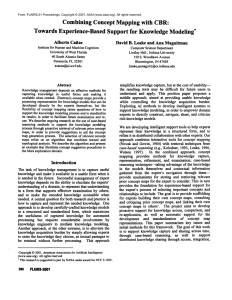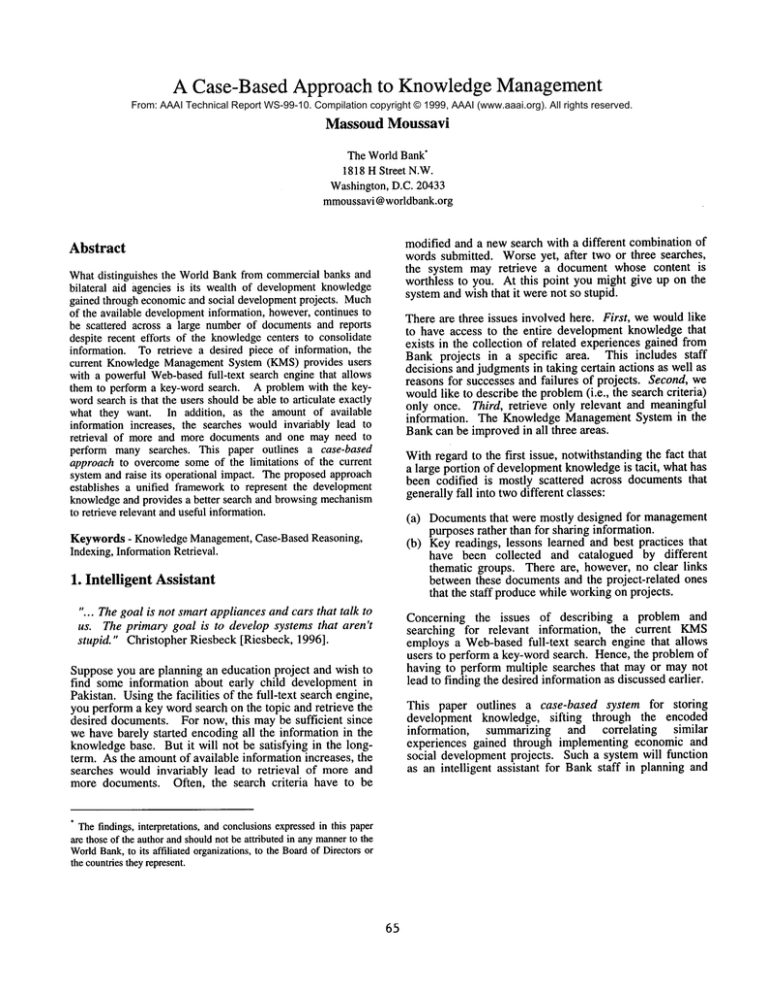
A Case-Based Approach to KnowledgeManagement
From: AAAI Technical Report WS-99-10. Compilation copyright © 1999, AAAI (www.aaai.org). All rights reserved.
Massoud Moussavi
The WorldBank"
1818H Street N.W.
Washington,D.C. 20433
mmoussavi@worldbank.org
Abstract
Whatdistinguishes the WorldBankfrom commercialbanks and
bilateral aid agencies is its wealth of developmentknowledge
gained througheconomicand social developmentprojects. Much
of the available development
information,however,continuesto
be scattered across a large numberof documentsand reports
despite recent efforts of the knowledgecenters to consolidate
information. To retrieve a desired piece of information, the
current KnowledgeManagement
System (KMS)provides users
with a powerfulWeb-based
full-text search engine that allows
them to perform a key-wordsearch. A problemwith the keywordsearchis that the users shouldbe able to articulate exactly
what they want. In addition, as the amountof available
information increases, the searches wouldinvariably lead to
retrieval of more and more documentsand one may need to
perform manysearches. This paper outlines a case-based
approachto overcomesomeof the limitations of the current
systemand raise its operational impact. The proposedapproach
establishes a unified frameworkto represent the development
knowledgeand provides a better search and browsingmechanism
to retrieve relevantanduseful information.
Keywords- KnowledgeManagement,Case-Based Reasoning,
Indexing,InformationRetrieval.
1. Intelligent Assistant
"... The goal is not smart appliances and cars that talk to
us. The primary goal is to develop systems that aren’t
stupid." Christopher Riesbeck [Riesbeck, 1996].
modified and a new search with a different combinationof
words submitted. Worseyet, after two or three searches,
the system may retrieve a document whose content is
worthless to you. At this point you might give up on the
systemand wishthat it werenot so stupid.
There are three issues involved here. First, we wouldlike
to have access to the entire development knowledgethat
exists in the collection of related experiences gained from
Bank projects in a specific area. This includes staff
decisions and judgmentsin taking certain actions as well as
reasons for successes and failures of projects. Second, we
wouldlike to describe the problem(i.e., the search criteria)
only once. Third, retrieve only relevant and meaningful
information. The Knowledge ManagementSystem in the
Bankcan be improvedin all three areas.
Withregard to the first issue, notwithstandingthe fact that
a large portion of developmentknowledgeis tacit, what has
been codified is mostly scattered across documents that
generallyfall into twodifferent classes:
(a) Documentsthat were mostly designed for management
purposes rather than for sharing information.
(b) Key readings, lessons learned and best practices that
have been collected and catalogued by different
thematic groups. There are, however, no clear links
between these documentsand the project-related ones
that the staff producewhile workingon projects.
Concerning the issues of describing a problem and
searching for relevant information, the current KMS
employs a Web-basedfull-text search engine that allows
users to perform a key-wordsearch. Hence, the problem of
having to perform multiple searches that may or may not
lead to finding the desired informationas discussed earlier.
Supposeyou are planning an education project and wish to
find some information about early child development in
Pakistan. Usingthe facilities of the full-text search engine,
you perform a key wordsearch on the topic and retrieve the
desired documents. For now, this may be sufficient since
we have barely started encoding all the information in the
knowledgebase. But it will not be satisfying in the longterm. As the amountof available information increases, the
searches would invariably lead to retrieval of more and
more documents. Often, the search criteria have to be
This paper outlines a case-based system for storing
development knowledge, sifting through the encoded
information,
summarizing and correlating
similar
experiences gained through implementing economic and
social development projects. Such a system will function
as an intelligent assistant for Bankstaff in planning and
* Thefindings,interpretations,andconclusions
expressed
in this paper
are thoseof the authorandshouldnotbe attributedin anymanner
to the
World
Bank,to its affiliated organizations,
to the Boardof Directorsor
the countries
theyrepresent.
65
implementingtheir projects. It wouldraise the operational
impact of the KMSby providing:
situation by remembering, modifying and applying prior
experience. That is, one uses case-based reasoning.
¯
The case-based nature of the knowledge about economic
and social development has also been discussed in
[Denning 1999; Ellerman, 1999]. According to Ellerman, a
"best practice" might workwell in somecountries but fail
miserably whenrecommendedin other contexts.
¯
A unified frameworkto represent the knowledgethat a
task managerputs into the work, the lessons learned
and good practices, as well as the information that a
help desk staff collects in responseto an inquiry.
A search and browsing mechanismthat is superior to
traditional search engines in retrieving relevant and
useful information.
What constitutes
a case? Each development project
embodiesa certain numberof characteristics which, taken
together, represent a case. The content of a case should
include:
2. Knowledge Managementin the World Bank
The stated goals of the Bank’s KMSare to increase staff
effectiveness in doing their work and to capture and share
development knowledge and experience with others. As
discussed in [Hansen et al., 1999] there are two very
different knowledgemanagementstrategies: codification
where knowledgeis codified and stored in databases and
personalization where knowledgeis shared through direct
person-to-person contacts. The knowledge management
efforts in the Bankare in fact aimedat achieving the right
balance between codification
and personalization
strategies. Recent discussions in the Bank[Denning, 1999]
have centered on the role of the Bankas a storehouse as
well as a broker of knowledge. The KMstrategy of the
World Bankis not limited to codification of knowledgeor
building a Web-site; knowledgesharing does indeed take
place also through seminars, task team missions, and
informal interactions. In this paper, we deal, of course,
only with knowledgethat can be automated.
¯
¯
¯
¯
Lessons learned, key readings, and the information that
a help-desk staff collects regarding a project. Note
that in responseto an inquiry, a help-deskstaff gathers
information for a particular situation (or case). It
important to capture and update this knowledgein a
database of cases.
Informal development knowledgeshared amongstaff.
Development information contained in different
reports and documents.
A course of action or solution to the problem.
A case is like a container that would hold the relevant
development information from several sources. In
addition, since most development knowledgeis contained
in the collection of related experiences, the cross-links
between different experiences (cases) are highly relevant
and can be established to reduce the retrieval overhead.
In order to understand the role of the KMS,it is useful to
distinguish between development knowledge, which has to
do with the content of the project related work (one’s
experiences and stories) and knowledge of processes,
which has to do with the flow of work. Staff whowork on
a project, say a child education project in India, need to
learn about the relevant best practices or failures and
successes of similar projects (i.e., developmentknowledge).
They also need to know who to contact for certain
questions, what the Bank’s policy is concerninga particular
issue, howto meet deadlines, howto write a report, howto
meet the expectations of their managers, etc. (i.e.,
knowledgeof processes).
4. System’s Architecture
Muchof the knowledgemanagementeffort in the Bank has
focused on providing staff with knowledgeof processes.
For example, staff might want to use a Termsof Reference
documentso that they can modify it to suit their need; or
they might want to study Bankguidelines concerning loans
to client countries. While the system also provides access
to a large number of documents, it does not provide a
mechanism to extract development knowledge from these
documents. But focus on content is one of the important
features of a KMS[O’Leary, 1998].
¯
The proposed system would allow the staff working on
different developmentprojects to navigate through a library
of prior developmentprojects and case studies to find an
example that is similar to their situation,
using a
"conversational CBR"framework [Aha and Breslow 1997].
The users are promptedto answer questions as the system
searches the case library for partially matchingcases, and
presents best cases to them. The users can then suggest
changesand this cycle is repeated until a most similar case
to their problem is found. As shown in Figure 1, the
system would be composedof three integrated components:
¯
3. A Case-Based Framework to Represent
Development Knowledge
¯
Developing a World Bank project belongs to a class of
"weak theory" problem solving domains such as medicine,
social work, and law in which tasks are not algorithmic and
one maynot always be able to reason and plan based on a
set of first principles. Rather, one deals with a new
66
A case library containing concrete cases of
developmentprojects. It includes description of the
approach taken to solve a problem in a country,
lessons learned, pictures, samplevideo and audio clips,
etc. Associated with this library is an indexing
vocabulary that captures important features of
development cases and thereby distinguishes one case
from another.
A knowledge base that contains general domain
knowledgein the form of relations amongfeatures and
heuristic rules. Armedwith the domain knowledge,
the system would be able to provide some general
prescriptive advice concerning what methodsto use in
certain conditions(i.e., best practices).
A situation assessment user interface that derives
more meaningful features before attempting retrieval
of a useful case. What distinguishes this component
from standard information retrieval systems and Web
search engines is its capability of using project-related
problemof formulating the right query to the user whomay
search for "scholarship", "stipend" or "female education",
etc. But invariably, one will find more documentsthan one
would like; some of the retrieved documents may not be
relevant at all and several searches mayhave to be carried
out to find the relevant information.
semantic vocabulary to help the user to formulate a
query.
UserInput
l
A case-based system, on the other hand, retrieves
information based on its indexes. Considering the above
document (as well as other documents in the area of
education), we can select the following features for
indexing: religion, cultural atmosphere, existence of
segregation problem, economic condition,
gender
discrimination, type of stipend, type of community,female
teachers, etc. These are in fact part of the indexing
vocabularydiscussed earlier.
Situation
Assessment
User
Interface
Figure 1: Situation Assessment& Retrieval Component
It is important to point out that the proposedsystemleaves
adaptation of a case to the user. The system only helps to
retrieve a case that can be adapted and when possible it
suggests a "best practice". But as described in [Ellerman,
1999], it is difficult to knowa priori just howgeneral is a
"best practice" and often the local adaptation amountsto
reinventing the "best practice" in the newcontext.
5. Search and Retrieval:
Armed with such a vocabulary,
CBR assesses and
interprets a newsituation (situation assessment)to derive
more meaningful features before attempting retrieval of a
useful case [Leake 1996]. The system would lead the user
through a number of questions based on the indexes
describedabove. That is, it inquires about religion, cultural
atmosphere, type of community, etc. Given that one is
interested in a scholarship program for Muslimgirls in
rural areas, the system would retrieve the mentioned
document plus some other documents like "Bangladesh:
FemaleSecondary School Assistance Project". In addition,
it maydetermine that the following Bank documents are
also relevant: "Girls’ scholarship pilot in Guatemala"and
"China: Third Basic Education Project". (The latter
documenthas a section on Muslimminority in rural areas
in China.) Figure 2 shows a prototype of such a system
using the Inference Corporation’s CBRtool.
An Example
The retrieval of cases is closely related to the indexing
method used.
Indexes are labels that designate
circumstances under which the case suggests a solution or
anticipates a failure. One can distinguish between two
types of case information: Indexedinformation that is used
for retrieval, and non-indexed information. For example,
in a system for retrieving information about child education
we may use type of community and economic condition as
two of the indexed features that can be used for retrieval
and we may include graphs, photographs, and most of the
text as features that are not indexed. In this example, a
search can be performedbased on the values of the indexed
attributes (e.g., type of community: rural, economic
condition: poor). Clearly, this is different from a keyword
search in which one wouldsearch for words such as "rural"
or "poor" and retrieve all documents(including those that
are not relevant) that contain these words.
To illustrate
further, consider a Bank document on
educationin Pakistan. In its conclusion,the paper states:
"... It is better for the Governmentto give the village
education committee the money directly. They will
choose better...Although early evidence from Balochistan
seems promising, the process maynot easily be replicated
in all rural communities.The absence of qualified female
teachers and the community unwillingness to form a
village education committee and establish a school in
some communities will be the two main obstacles for
further expansion of the pilot programs... There are also
some orthodox Muslim families who do not send their
girls to school and are of the view that education spoils
the character of girls."
Figure 2: Anexampleuser interface
The retrieval process described above uses semanticsimilarity metrics to retrieve most "similar" cases. Most
CBRsystems (including the Inference CBRtool) employ
this technique. However, the most similar case may not
necessarily be the easiest to adapt. Adaptation-guided
retrieval is a novel technique that assesses the adaptation
requirements of cases during retrieval [Smyth and Keane,
Assumethat a user is planning an education project and is
interested to find information about scholarship programs
for Muslimgirls in rural areas. The information retrieval
mechanism employed by the existing KMS,leaves the
67
1995]. Adaptation of cases in the proposed system is left
up to the user as adapting developmentknowledgeto local
conditions and culture requires considerable effort
[Ellerman, 1999]. However,if the information concerning
the cost of adaptation of a case is available, one might be
able to link similarity assessment directly to adaptation
knowledge[Leake et al., 1996].
I would like to thank Ulrich Hewerand Roberto Chavezfor
their encouragement and many valuable discussions
regarding this paper. I would also like to thank Mohamed
Muhsin and Steve Denning for their support and
encouragement; Debra Basilis, Jahangir Boroumand,Ana
Flavia Fonseca, Cheryl Kariya, Evelyn Anna Kennedy,Bill
Lange, David Leake, Ali Semsarzadeh, and the AAAI
reviewers for their commentsand productive feedback.
6. Summary
References
Building a case-based system to represent development
knowledgeis a big challenge because it implies indexing
every document - a large task. But we can start with a
portion of the existing documents, say the ones on most
recent projects, sift through them, correlate similar
experiences, and create a database of cases containing
development information.
[Aha and Breslow, 1997] Aha, D. W. and Breslow, L.A.
(1997). Refining Conversational Case Libraries.
Proceedings of the Second International Conference on
Case-Based reasoning, pages 267-278. Providance, RI:
Springer-Verlag.
[Denning, 1999] Denning, S. (1999). KMBrainstorming
of April 9. A World Bank Internal Document.
One successful implementationof a case-based system is at
the NECCorporation [Kitano et al., 1992]. There is, of
course, a major difference between knowledgemanagement
in the Bank and at the NECCorporation. Quality of
development projects is muchharder to measure than the
quality of software products and capturing development
knowledge is considerably more complex than software
development skills. Nevertheless, NEC’sexperience in
developing a large-scale case-based system is a promising
application of the CBRconcept to creating a corporate
memory.
[Ellerman, 1999] Ellerman, D. (1999). Global Institutions:
Transforming International Development Agencies into
Learning Organizations. The Academy of Management:
Executive, V. 13 (1, Feb. 99), pages 25-35.
[Hansen et al., 1999] Hansen, M.T., Nohria, N., and
Tireney, T. (1999). What’s Your Strategy For Managing
Knowledge. Harvard Business Review, March-April 1999,
pages 106-116.
[Kitano et al., 1992] Kitano, H., Shibata, A., Shimazu,H.,
Kajihara, J., and Sato, A. (1992). Building Large Scale
and Corporate-Wide Case-Based Systems. In Proceedings
of the Tenth National Conferenceon Artificial Intelligence,
pages 843-849. Menlo Park, CA: American Association
for Artificial Intelligence.
A case-based system as an integral part of the KMSoffers
the following advantages:
¯ Summarizes all relevant
project
development
informationin one place (i.e., a case-base).
¯
Provides a search mechanismthat is superior to the
traditional search engines employed by the KMS,in
retrieving relevant and useful information.
¯
Providesa better user interface so that the users do not
need to have extensive prior knowledge about the
domain in order to find what they want in the
knowledgebase.
¯
A deeper level of knowledgeis obtained because of the
cross-links betweensimilar cases. A system that links
related experiences would have significantly higher
operational value.
¯
Once the cross-links are established, browsing of
relevant information becomessimpler.
¯
It can significantly improvethe quality of training and
is particularly useful for distance learning.
[Leake, 1996] Leake, D. (1996). CBRin Context: The
Present and Future. In D. Leake, editor, Case-Based
Reasoning: Experiences, Lessons, & Future Directions,
pages 3-30. Menlo Park, CA: AAAIPress.
[Leake et al., 1996] Leake, D., Kinley A., and Wilson, D.
(1996) Acquiring case adaptation knowledge: A hybrid
approach. In Proceedings of the Thirteenth National
Conference on Artificial Intelligence, pages 684-689,
Menlo Park, CA: AAAIPress.
[O’Leary, 1998] O’Leary, D. E. (1998). Knowledge
ManagementSystems: Converting and Connecting. IEEE
Intelligent Systems, May/June1998, pages. 30-33.
A long-term opportunity would be to augmentthe retrieval
componentwith a browsable case-base where the cases are
richly indexed with inter-case links. This meansthat there
will be no predefinedretrieval involved: the user selects an
initial case and then follows the links to other relevant
cases based on the user’s interests. In this regard, the
general approach of the ASKsystems [Schank et al., 1991]
for building a conversational advice-giving system can be
employed.
[Riesbeck, 1996] Riesbeck, C. (1996). What Next? The
Future of Case-Based Reasoning in Post-Modern AI. In D.
Leake, editor, Case-Based Reasoning: Experiences,
Lessons, & Future Directions, pages 371-388. Menlo
Park, CA: AAAIPress.
[Schank et al., 1991] Schank, R., Ferguson, W., Birnbaum,
L., Barger, J., and Greising, M. (1991). ASK-TOM:
experimental interface for video case libraries.
In
Proceedingsof the Thirteenth Conference of the Cognitive
Science society. Northvale, NJ: Erlbaum.
Acknowledgements
68
[Smyth and Keane, 1995] Smyth, B., and Keane, M.T.
(1995). Experiments on adaptation-guided retrieval
case-based design.
In Proceedings of the First
International Conference on case-Based Reasoning, pages
313-324. Sesimbra, Portugal: Springer-Verlag.
69

